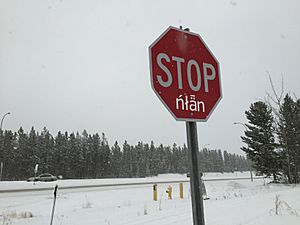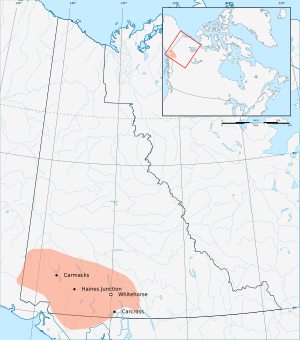Southern Tutchone facts for kids
The Southern Tutchone are a group of First Nations people. They live mostly in the southern Yukon in Canada. They are part of the Athabaskan-speaking family. Their traditional language is called Southern Tutchone. Some language experts think Northern and Southern Tutchone are separate languages.
Several Southern Tutchone First Nations governments and communities exist today:
- Champagne and Aishihik First Nations in Haines Junction, Champagne, and Aishihik in Yukon. Many members also live in Whitehorse.
- Ta'an Kwach'an Council in Whitehorse, Yukon and Lake Laberge. Their name, Ta’an Kwäch’än, means "People of Lake Laberge." They called the lake Tàa'an Män.
- Kluane First Nation in Burwash Landing, Yukon. Their name, Lù’àn Män Ku Dän or Lù’àn Mun Ku Dän, means "Kluane Lake People." This refers to their land around Kluane Lake.
Many people from the Kwanlin Dün First Nation in Whitehorse are also Southern Tutchone. Their name, Kwänlin Dän kwächʼǟn, means "Whitehorse people." It comes from a part of the Yukon River from Miles Canyon Basalts to the White Horse Rapids. Their ancestors called this area Kwanlin, meaning "running water through canyon." When combined with the Southern Tutchone word Dän or Dün for "people," it describes the "Whitehorse people."
Contents
The Southern Tutchone Language
The Southern Tutchone people speak a language that is part of the Athabaskan family. This language is often called "Dän'ke" today. This means 'our way' or 'our culture'. It can also be called "Dän k'e kwänje," which means 'our way of speaking'. The Southern Tutchone traditional land covers the southwest Yukon.
A researcher named Catharine McClellan divided the Tutchone language into two groups. She called them Southern Tutchone and Northern Tutchone. The two languages are similar, but they have small differences in how they are spoken.
How Many Southern Tutchone Speakers Are There?
In the early 1950s, there were about 20,000 people who spoke Southern Tutchone. Sadly, this number has dropped a lot. As of 2004, only 404 people spoke Southern Tutchone as their first language. A total of 645 people had some knowledge of the language. Today, there are fewer than 100 speakers. This means it is an endangered language.
Helping the Language Grow Again
Many efforts are being made to help the Southern Tutchone language. These efforts aim to increase the number of people who speak it.
- You can see signs throughout the Yukon that highlight the language.
- There is an adult program where people can learn the language by being fully surrounded by it. This program is in the traditional land of the Champagne and Aishihik First Nations.
- In 2015, the Champagne and Aishihik First Nations started the first Da Ku Nän Ts'tthèt dance festival. This festival focused on Southern Tutchone language and culture. It was held at the Da Ku cultural centre, which means "our house" in Southern Tutchone.
- Schools in the area also have programs to teach the language. There is even a "language nest" in Haines Junction, Yukon. A language nest is a place where young children learn their traditional language.
- The Yukon Native Language Centre has been very important in these efforts. They have created programs to train Indigenous teachers. They also develop learning materials for the language.
Southern Tutchone Land Claims
In the Southern Tutchone area, four First Nations governments have officially settled their land claims. This means they have agreements about their traditional lands. These nations include:
- Champagne and Aishihik First Nations in Haines Junction
- Ta'an Kwach'an Council in Lake Laberge
- Kluane First Nation in Burwash Landing
- Kwanlin Dün First Nation in Whitehorse
See also



